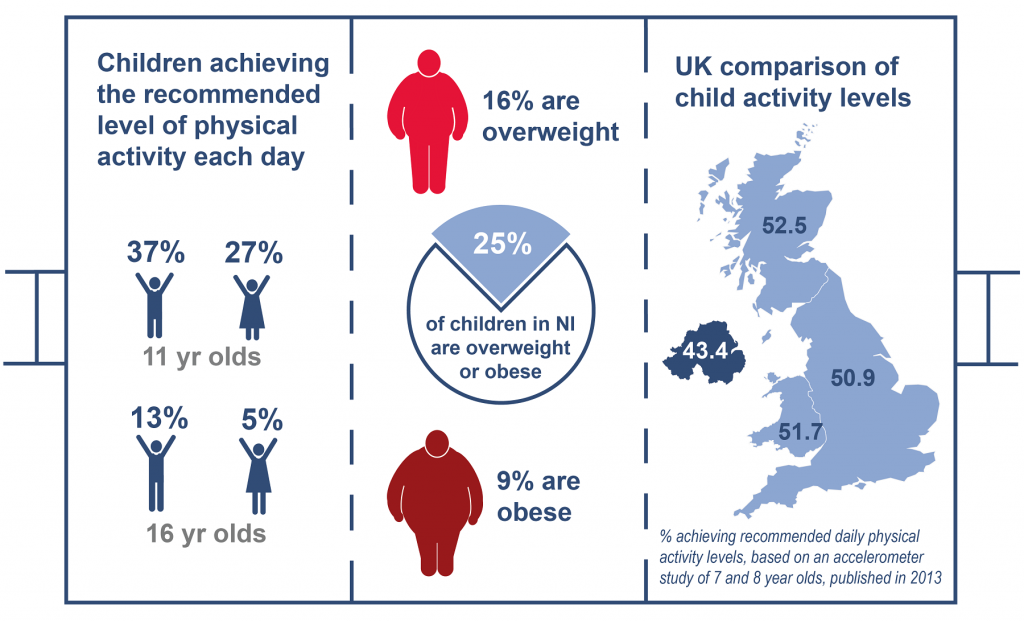Childhood obesity and inactivity – a lifelong problem?
By Lesley-Ann Black & Dan Hull

This article examines levels of childhood obesity and inactivity in our children in Northern Ireland and asks what more can be done to address this public health problem.
A World Health Organization commission has described childhood obesity as a ‘growing epidemic’ globally, and stated that it is ‘under-recognized as a public health issue’. Alarmingly, in Northern Ireland at least 25% of children are classed as overweight or obese. Children are also becoming obese younger and are more likely to be obese as adults if they were obese as children. Inequalities also exist, as the research shows that children living in the most deprived areas in Northern Ireland are at greater risk of becoming overweight or obese.
Obesity can be defined as ‘a condition of excessive body fat or adiposity that exceeds healthy limits’. It is caused by a number of factors including our behaviour, sedentary lifestyles and genetics. A key factor is energy imbalance, which occurs when too many calories – particularly from high fat/sugar foods – are ingested, but are not used in the body. The relationship between the amount of calories eaten and the amount of energy used determines our body weight and overall health. Too many calories lead to excessive fat and potentially long-term health effects. For example, these include an increased risk of developing Type 2 diabetes, cardiovascular disease, elevated blood pressure, some cancers, chronic illnesses, disability and reduced life expectancy. A recent report by the organisation Safefood concluded that,
The available evidence suggests that children and adolescents who are overweight or obese have lower self-esteem and social support, greater loneliness, sadness and nervousness, are more likely to drink and smoke and have lower health-related quality of life in adulthood.
It has been estimated previously that the direct healthcare costs and indirect costs to society of adult overweight and obesity is €510 million (around £450 million) for Northern Ireland, with direct costs representing around 2.8% of total healthcare expenditure. A more recent study has concluded that the total lifetime cost of childhood obesity in Northern Ireland is around £2.1 billion, or £18,797 per person.
Yet being overweight or obese is largely preventable.
The role of nutrition
In terms of nutrition, food choices made by parents of young children and children themselves are not always healthy. Healthy foods are often a more expensive option, and may not always be affordable for low income families. Moreover, unhealthy foods are readily available, and subject to attractive marketing and price promotion strategies. Coupled with this, food portion sizes have increased substantially over the past 50 years.
Whilst schools across Northern Ireland play a key part in contributing to childhood nutrition and to the development of the knowledge and skills necessary to be able to make healthier food choices, it is clear that more needs to be done. Currently schools are expected to follow mandatory Nutritional Standards for School Meals. An evaluation of these standards in 2016 found that 69% of school principals said that their school complied with them. However, packed lunches and tuck shops are a different matter. These kinds of foods also have nutritional standards, but just 52% of principals said that their school complied with these. Realistically, it is more difficult for schools to monitor what children bring in for lunch or have at snack time. Just 18% of post-primary schools stated that they provided parents with information on healthy snacking. Previous surveys have indicated that children in Northern Ireland are eating around three times more sugar than they should and that 9 out of 10 packed lunches are far too high in fat and sugar content. Furthermore, by the time a child reaches secondary school, it is much harder to influence what they are eating, with some older children allowed to leave school premises to purchase food elsewhere.
Poor physical activity levels
In addition to a poor diet, a lack of physical activity is another factor driving the obesity crisis. Although physical activity can help prevent weight gain, it also has several other health benefits for children, including:
- Muscle and bone strength
- Health and fitness
- Improved quality of sleep
- Maintenance of a healthy weight
- Improved academic performance
- Mental/psychological health benefits, including increased self-esteem
The Chief Medical Officers of the UK recommend that adults spend 30 minutes a day at least five times a week carrying out moderate physical activity, but for those under 18 the target is 60 minutes per day, seven times a week. Research published in 2016 revealed that just 9% of 16-year olds in Northern Ireland meet this target, and 32% of P7 children.
Furthermore, there is a noticeable difference in activity levels between girls and boys in both the P7 age group as well as among 16 year olds: for P7s, 63% of boys did not achieve the physical activity target of 60 minutes per day, compared with 73% of girls. Among 16 year olds, 87% of boys did not achieve the target, compared with 95% of girls; the relative inactivity of females compared with males is a persistent feature of exercise statistics in Northern Ireland, as explored in a previous blog post.
And yet it seems there is a high level of awareness among 16 year olds that physical activity is a key element of a healthy lifestyle, with 91% saying that it is ‘very’ or ‘somewhat’ important. 69% cited a lack of time as the single most important factor in preventing them from being more active.
Only around half of survey respondents indicated that they did physical education (PE) at school during a normal week: 44% of 16 year olds and 53% of P7 pupils. While the Education (Curriculum Minimum Content) Order (Northern Ireland) 2007 specifies that physical education is a statutory requirement, at present no specific amount of time has to be allocated to physical education in the curriculum.
A study conducted in 2010 by Sport NI found that the overall average weekly time spent on curricular PE in post-primary schools in Northern Ireland during the academic year was 85 minutes; by contrast, the Sport Matters strategy recommends that government should pursue a target of two hours physical education and school sport per week.
Comparing Northern Ireland with other nations and regions can be difficult as there are often differences in the ways in which measurements and surveys are conducted, but a large-scale accelerometer study published in 2013 found that children in Northern Ireland are the least active of any region of the UK.

Tackling childhood obesity requires action on a number of levels, from individuals to communities and government. According to the World Health Organization Commission on Ending Childhood Obesity, progress in tackling childhood obesity has been slow and inconsistent.
In 2007 the Department of Health published a Fit Futures Implementation Plan which dealt specifically with childhood obesity. Currently a population-wide strategy for obesity prevention is in place entitled A Fitter Future for All. This is accompanied by an outcomes framework with targets to reduce the proportion of children who are overweight or obese by 2022.
The Public Health Agency (PHA) also fund several initiatives which are delivered in local communities that seek to prevent obesity. These include healthy eating and cooking programmes, as well as initiatives that promote walking, cycling, active play and weight management programmes. However, these initiatives are often targeted at certain groups or schools. It could be argued that all children should avail of mandatory heathy eating education and cooking programmes, and physical activity from an early age.
Increasing the percentage of children who meet the Chief Medical Officer’s recommendations on physical activity will require action from a range of departments, agencies and other bodies. For example, in its recent research paper Young People and Sport in Northern Ireland, Sport NI concludes that:
In school, PE should be treated as a subject that is just as important as Science, Maths or English, and ideally schools should offer opportunities for, and encourage, physical activity at break-time as well.
Beyond the school environment, a number of wider policies will also be of relevance here, including those which focus on how our children travel to school and how they spend their leisure time.
Last year, the Department for Education consulted on a Children and Young People’s Strategy. The consultation document stated that:
The Executive will prioritise the physical and mental health of our children and young people – with a focus on early interventions. Giving our children and young people the opportunity to enjoy long, healthy and active lives.
While the document does refer to the need to reduce childhood obesity and describes the importance of play (and particularly outside play), it contains no specific mention of the Chief Medical Officer’s recommendation of achieving 60 minutes of physical activity per day.
The challenges involved with improving activity levels and reducing obesity among the children of Northern Ireland are undoubtedly substantial, but it is equally clear that the consequences for not doing so in terms of public health in the future are also very great.



